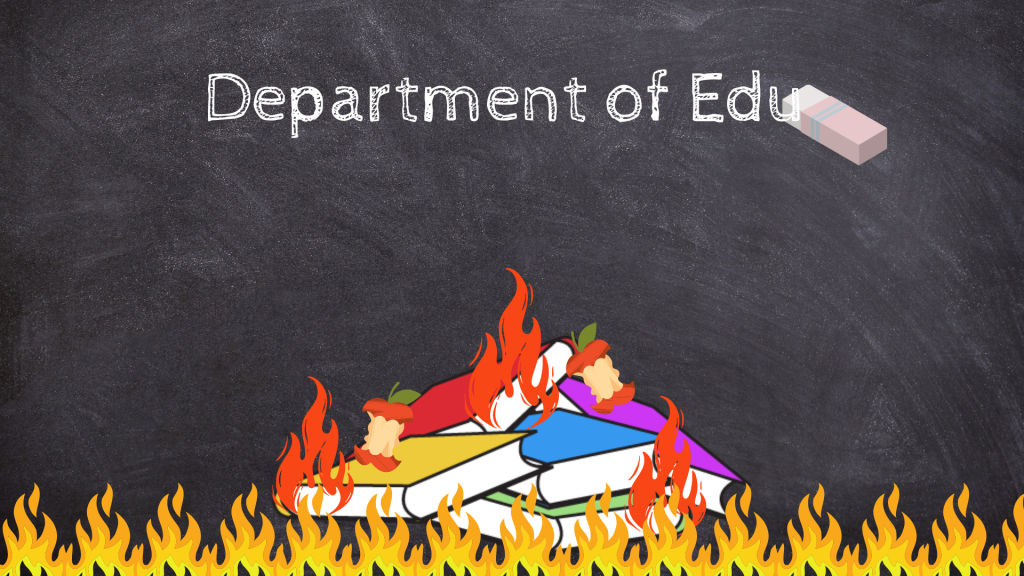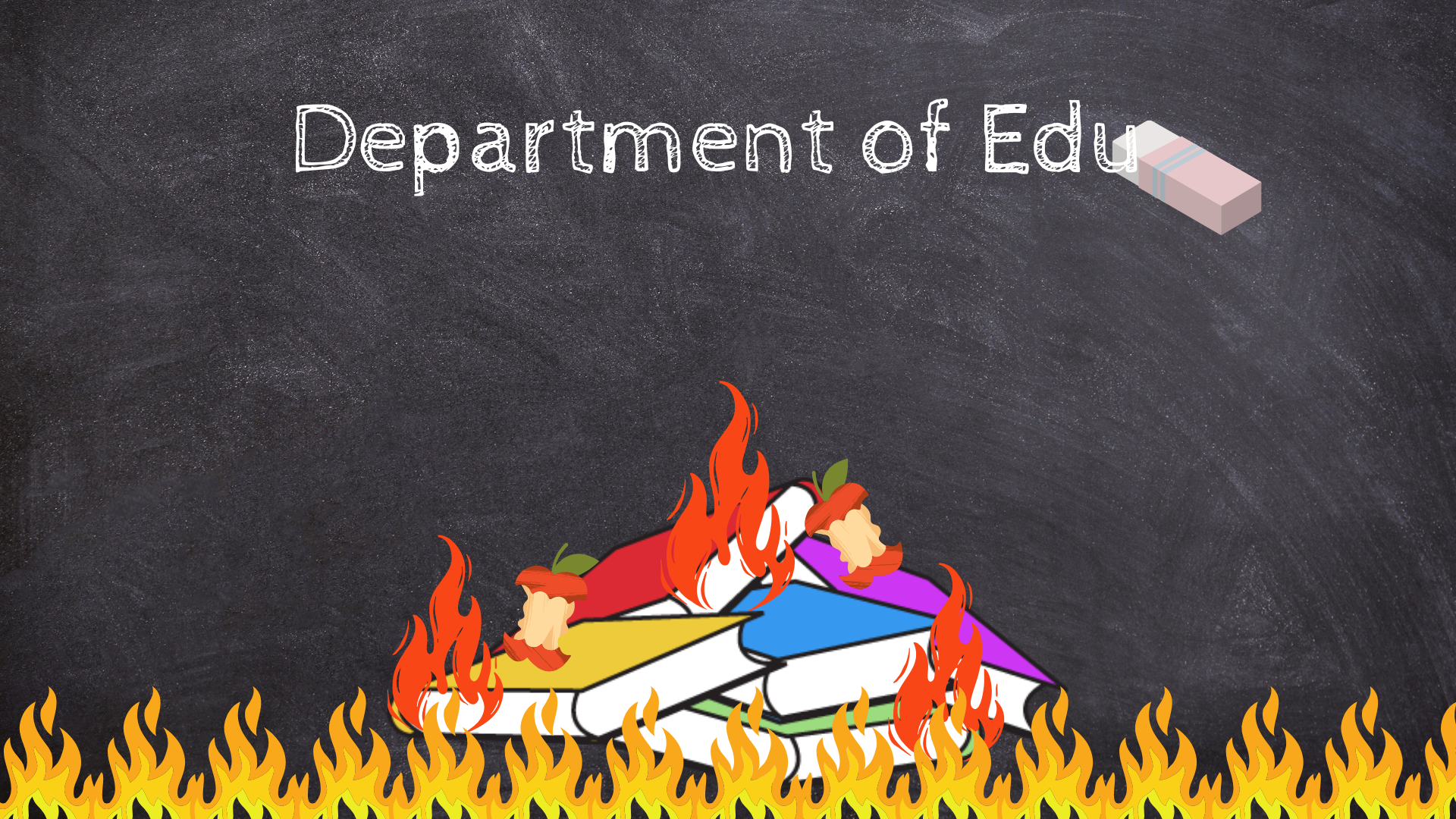
The wind chime sounds from below, dancing in the spring breeze. Thin strips of light peak through the blinds as the sun slinks beyond the horizon.
The sounds of springtime—birds chirping in the distance, leaves and wind chimes rustling in the breeze—are supposed to be hopeful, the dawning of a new season.
Today, it sounds like an omen.
My phone is open to the Mail app, the New York Times headline flashing at me.
“Trump Signs Order Aimed at Dismantling Education Department”
This wasn’t supposed to happen, as if I’d known it deep in my soul; my future, the one thing I’d been certain of since eighth grade, was not supposed to be ripped out of my hands and into the orange abyss of Donald Trump’s administration.
On March 20, 2025, at 4:41 p.m., the New York Times reported that Donald Trump had signed an executive order to begin dismantling the Department of Education. “We’re going to shut it down, and shut it down as quickly as possible,” Trump said during the signing.
The order argues that “Closing the Department of Education would provide children and their families the opportunity to escape a system that is failing them,” citing low test scores as the reason. It’s no secret that, statistically, test scores among school-aged children are low in the United States, as the education system slowly returns to pre-pandemic normalcy. Yet, the Department states its purpose as “ensuring access to equal educational opportunity for every individual.” The Department of Education does not dictate what a child can and cannot learn, that is left up to the states, but it sets standards in place to make sure that every child can be successful.
Even though the Department of Education cannot be dismantled without approval from both chambers of Congress, Trump has shown time and time again that he doesn’t care about checks and balances.
Then there is also the always prominent issue of history education.
History education has always been controversial to conservatives. In 2023, Florida Governor Ron DeSantis banned CollegeBoard from offering Advanced Placement (AP) African American History, stating that it violated Florida law, which prevents schools from teaching about slavery, racism, and White supremacy—otherwise known as Critical Race Theory.
The banning of Critical Race Theory creates an idealized society—think dystopian fiction like “The Giver” or “The Hunger Games”—that prevents and shelters students from learning about the darker but important parts of U.S. History that have helped to shape the country they live in today. It eliminates entire decades of curriculum that have been established to set a precedent and to make the world better in the future.
Maybe instead of trying to erase entire portions of the U.S. History curriculum, the U.S. government should make sure that students know what the three branches of government are.
A 2024 survey conducted by the Annenberg Public Policy Center found that 65 percent of the 1,620 Americans who were surveyed could name all three branches of government—executive, legislative, and judicial—but that 15 percent could not.
That is a rise from 2022, when the survey (conducted every year for Constitution Day) revealed that only 47 percent of Americans could name all three branches.
George Washington, the nation’s first president, once said, “a primary object of such a national institution should be the education of our youth in the sciences of government.” The passage of the No Child Left Behind Act in 2002 placed an emphasis on standardized testing, particularly in reading and mathematics, leading to a focus in classrooms on those subjects. A report conducted by The Center on Education Policy in 2007 found that school districts increased instructional time for reading and math by 43 percent, while instructional time for other subjects—like civics and history—decreased by 32 percent.
The majority of states—31—require high school students to complete a year of U.S. History, as of 2018. Only half of those states—Florida included—require students to take a U.S. History exam as part of their graduation requirements. In comparison, “only nine states and the District of Columbia require one year of U.S. government or civics, while thirty states require a half year.” This coupled with the current administration’s disregard for history education backs up the average scores for eighth grade students in U.S. History and Civics on the National Assessment of Educational Progress (NAEP) in 2022. These scores, which are reported on a scale from 0 to 500 for U.S. History and 0 to 300 for Civics, revealed the average in both tests were below proficient at 258 and 150, respectively.
As a future history teacher, I find these numbers certainly concerning; it’s a teacher’s goal to see their students succeed, not fail. That’s the thing, though; history teachers should be concerned with making sure that their students are succeeding, not looking over their shoulder in fear that they’ll be fired for teaching about civil rights or that America is in fact not the greatest country in the world. Conservatives argue that teachers should be focusing on reading and math, that they don’t have a right to “indoctrinate” the children, if that’s we’re calling history classes nowadays.
Yet, American democracy finds itself to be the most threatened it has been in nearly 250 years, while history and civics—classes that could perhaps restore it—are at the bottom of the educational food chain, essentially preventing the U.S. from moving forward.
Perhaps it’s time to realize the pitfalls in the American education system and realize that dismantling and defunding the Department of Education won’t do anything to fix it.
If not, what hope is there for the future?
The opinions on this page do not necessarily reflect those of The Sandspur or Rollins College. Have any additional tips or opinions? Send us your response. We want to hear your voice.















Comments are closed.